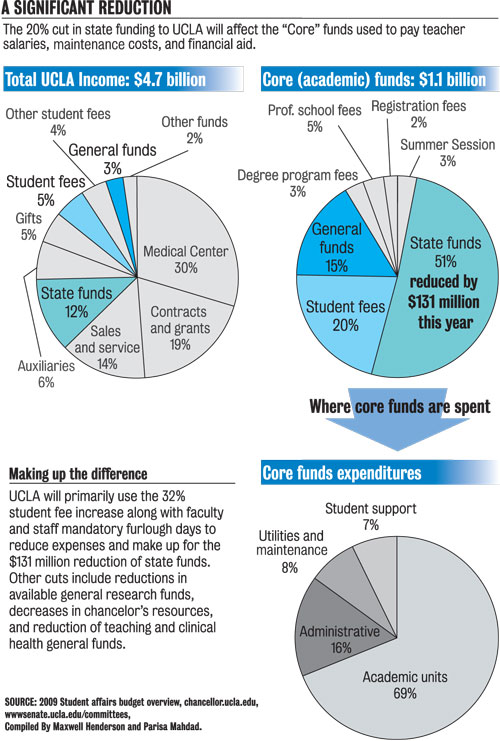Massive cuts to the budget continue to weigh on UCLA’s programs and operations.
Because state funding encompassed 51 percent of core funds, the large decrease in state funding in 2009-2010 has affected many facets of UCLA’s financial and academic operations, said Steve Olsen, vice chancellor of budget, finances and capital programs at UCLA.
To offset these budget cuts, the student affairs department has tried to consolidate its programming. For example, the Center for Women and Men has joined the Bruin Resource Center. In addition, the Sexual Assault Research and Information Center has moved to the Counseling and Psychological Services center, said Janina Montero, vice chancellor of student affairs.
“We are trying to maintain the level of support for students, but we cannot maintain the same structure,” Montero said.
However, she said that reduced service is inevitable with the presence of furlough days and the decrease in financial aid.
By February, the College should know exactly how much bridge money, or temporary money, is needed and how much the College can actually afford, said Judith Smith, vice provost of undergraduate education.
This year marks the first year that bridge money has been overwhelmingly requested by the provost of undergraduate education to maintain the current number of continuing lecturers and teaching assistants with an estimated $5 million to $6 million of bridge money being requested of the UC Office of the President.
“This is the first year of a clear budget crisis that has had an impact on academic programs,” Smith said.
In terms of conserving academic funds, Challenge 45 is a measure to reduce the budget and to insure that each academic department’s upper-division requirements do not exceed 45 units.
According to Smith, although the goal challenge is not mandatory, it has already found successful responses from departments such as the political science, Afro-American studies and Chicano studies.
The Faculty Executive Committee will also examine language requirements, as UCLA has one of the most rigid language requisites in the country, Smith said. The number of general education as well as quantitative reasoning requirements may also be lowered in the future.
“We are asking what’s really essential,” Smith said. “We want to teach more of the core at UCLA.”
The Faculty Executive Committee is in charge of UCLA curriculum and includes all ladder faculty, or permanent professors, of the College.
Each member of the ladder faculty, which includes nearly 1,000 professors, receives a ballot to vote on curriculum decisions, although he or she may choose whether or not to use it during a Faculty Executive Committee meeting, according to Smith.
Thus, the Faculty Executive Committee must pass these curriculum alterations before requirement reductions that help to cut the budget can take effect.
Although the budget cuts have decreased the number of courses offered, the number of seats in remaining courses have remained the same. This means that students have less flexibility in the classes they choose, but that classes are being put to more effective use, she said.
“Students need to understand that we have worked really hard in the College to make courses still available,” Smith said.
Because 87 percent of general funds allotted to the faculty comprise the salaries of ladder faculty, funds used to finance the temporary faculty’s salaries have been almost completely depleted. Continuing lecturers and teaching assistants comprise UCLA’s temporary faculty.
Continuing lecturers must be given a year’s notice of dismissal before the date of termination. This past year, 60 letters notifying layoffs were sent to these temporary members of faculty, Smith said.
